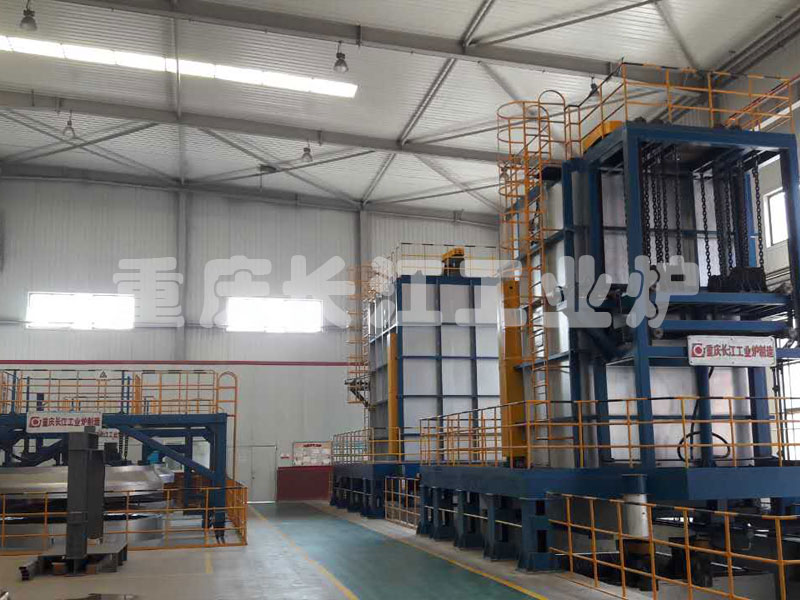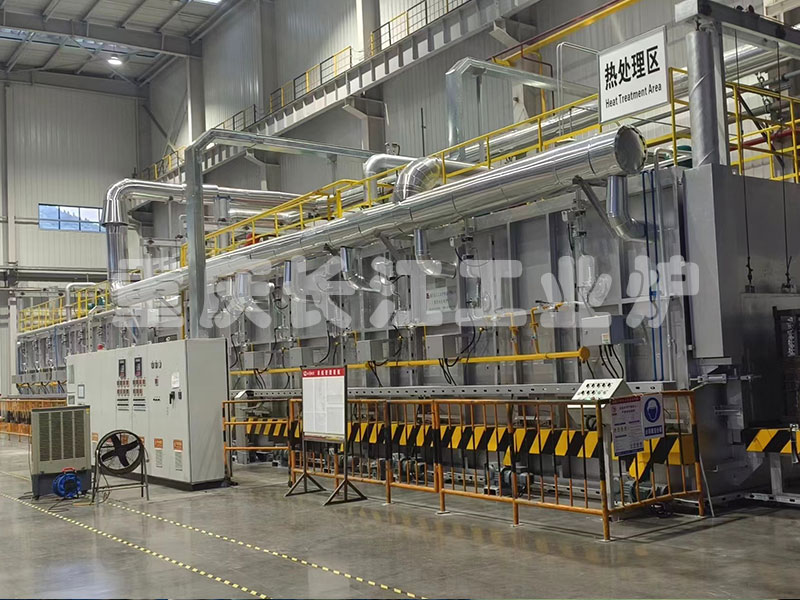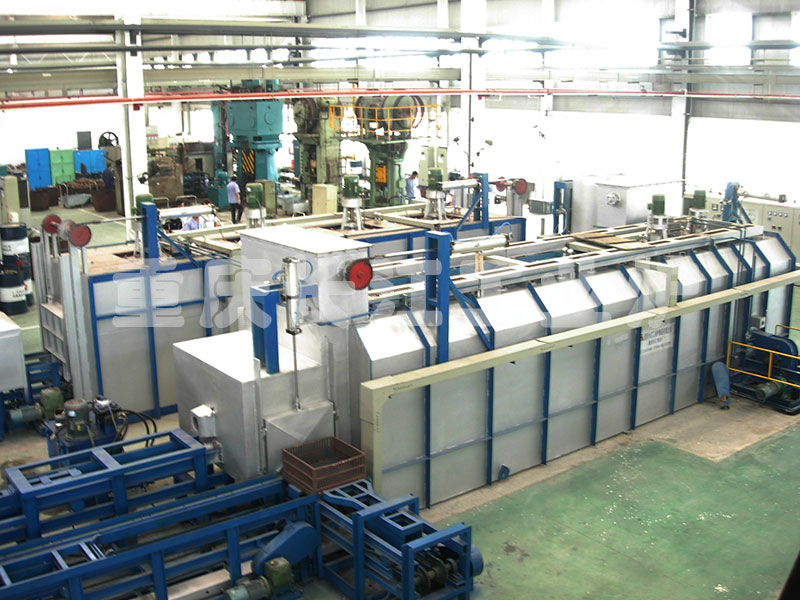A metallurgical furnace that utilizes the electric heating effect for heating. Electric furnace equipment is usually a complete set, including the furnace body, power equipment (furnace transformer, rectifier, frequency converter, etc.), switch, auxiliary electrical appliances (current resistors, compensation capacitors, etc.), vacuum equipment, detection and control instruments (electrical instruments, thermal instruments, etc.), automatic adjustment system, furnace mechanical equipment (feeding and discharging machinery, furnace body tilting device, etc.). The power equipment and detection and control instruments of large electric furnaces are generally concentrated in the power supply room of the electric furnace. Compared with fuel furnaces, electric furnaces have the following advantages: the atmosphere inside the furnace is easy to control, and can even be vacuumed; Fast material heating, high heating temperature, and easy temperature control; The production process is easier to achieve mechanization and automation; Good labor hygiene conditions; High thermal efficiency; Good product quality, etc. In the metallurgical industry, electric furnaces are mainly used for melting, heating, and heat treatment of steel, ferroalloys, non-ferrous metals, etc. At the end of the 19th century, industrial scale electric furnaces emerged. Since the 1950s, due to the increase in demand for advanced metallurgical products and the decrease in electricity costs with the development of the power industry, the proportion of electric furnaces in metallurgical furnace equipment has been increasing year by year. Electric furnaces can be divided into resistance furnaces, induction furnaces, electric arc furnaces, plasma furnaces, electron beam furnaces, etc.
A resistance furnace is an electric furnace that uses the Joule heat generated by the passage of current through a conductor as the heat source. According to the method of electric heating generation, resistance furnaces are divided into two types: direct heating and indirect heating. In a direct heating resistance furnace, the current flows directly through the material. Due to the concentration of electric heating power on the material itself, the material is heated quickly, making it suitable for processes that require rapid heating, such as the heating of forging billets. This type of resistance furnace can heat materials to very high temperatures, such as carbon material graphitization electric furnace, which can heat materials to over 2500 ℃. Direct heating resistance furnace can be used as a vacuum resistance heating furnace or a protective gas resistance heating furnace. In powder metallurgy, it is commonly used for sintering tungsten, tantalum, niobium and other products. When using this type of furnace for heating, attention should be paid to: ① to ensure uniform heating of the material, it is required that the conductive cross-section and conductivity of each part of the material are consistent; ② Due to the relatively small resistance of the material itself, in order to achieve the required electric heating power, the working current is quite high. Therefore, the contact between the transmission electrode and the material should be good to avoid arcing and burning the material, and the resistance of the transmission bus should be small to reduce circuit losses; ③ When supplying AC power, it is necessary to configure the short network reasonably to avoid excessive inductance and low power factor.
Most resistance furnaces are indirect heating resistance furnaces, which are equipped with resistance bodies specifically designed to achieve electrical thermal transformation, called electric heating bodies, which transmit heat energy to the materials in the furnace. This type of electric furnace shell is made of steel plate, and the furnace is lined with refractory materials, with materials placed inside. The most commonly used heating elements are iron chromium aluminum heating elements, nickel chromium heating elements, silicon carbide rods, and molybdenum disilicide rods. According to needs, the atmosphere inside the furnace can be ordinary atmosphere, protective atmosphere, or vacuum. The general power supply voltage is 220V or 380V, and if necessary, an intermediate transformer with adjustable voltage is configured. Small furnaces (<10 kW=single-phase power supply, large furnaces three-phase power supply. For materials with a single variety and large batch size, continuous furnace heating should be used. Resistance furnaces with furnace temperatures below 700 ℃ are mostly equipped with blowers to strengthen heat transfer inside the furnace and ensure uniform heating. Resistance furnaces used for melting fusible metals (lead, lead bismuth alloys, aluminum, magnesium and their alloys, etc.) can be made into crucible furnaces; Alternatively, it can be made into a reflecting furnace with a molten pool and installed with an electric heating element on the top of the furnace. An electroslag furnace is a resistance furnace that converts slag into electric heating (see electroslag remelting).
An electric furnace that utilizes the induction heating effect of materials to heat or melt them. The basic component of an induction furnace is an induction coil wound with copper tubes. Applying AC voltage to both ends of the induction coil generates alternating electromagnetic fields. Conductive materials are placed in the induction coil, and due to electromagnetic induction, eddy currents are generated in the material. Under the action of resistance, electrical energy is converted into thermal energy to heat the material; Therefore, induction heating can also be considered as a direct heating type of resistance heating.
The characteristic of induction heating is that the electric power (current distribution) transformed in the heated material is very uneven, with the largest surface and the smallest center, known as the skin effect. In order to improve the electric heating efficiency of induction heating, the power supply frequency should be appropriate. Small melting furnaces or surface heating of materials should use high-frequency electricity, while large melting furnaces or deep penetration heating of materials should use medium frequency or power frequency electricity. Inductive coils are loads with a considerable amount of inductance, and their power factor is generally very low. In order to improve the power factor, induction coils are generally connected in parallel with capacitors, called compensation capacitors. The gap between the induction coil and the material should be small. The induction coil should be made of square copper tube, with water cooling inside the tube. The inter turn gap of the induction coil should be as small as possible, and the insulation should be good. Induction heating device is mainly used for the melting and casting of steel, copper, aluminum, zinc, etc. It has fast heating, low burning loss, high mechanization and automation, and is suitable for configuration on automatic operation lines.
The induction melting furnaces used in industry include crucible furnaces (coreless induction furnaces) and groove furnaces (cored induction furnaces),. The crucible is made of refractory material or steel, with a capacity ranging from a few kilograms to dozens of tons. The melting characteristic is that the melt in the crucible is subjected to electric force, forcing the liquid level of the molten pool to protrude, and the melt flows from the center of the liquid level to the surrounding areas, causing cyclic flow. This phenomenon is called the electric effect, which can make the melt composition uniform. The disadvantage is that the slag tends towards the periphery and has poor coverage. Compared with the melting groove furnace, the crucible furnace has flexible operation, high melting temperature, but low power factor and high power consumption. The inductor of the melt groove furnace is composed of an iron core, an induction ring, and a melt groove furnace lining. The melt groove is one or two banded circular grooves, which are filled with molten material connected to the melt pool. In principle, a trench furnace can be regarded as an iron core transformer with only one turn of coil and a short circuit in the secondary. Inductive current flows in the melt of the melt groove, achieving electrothermal transformation.
In production, after each furnace of metal melting is completed, the molten pool cannot be emptied, and a portion of the melt must be retained as the starting melt for the next furnace. The temperature of the melt groove is higher than that of the melt pool, and it also bears the erosion of the melt flow, so the furnace lining of the melt groove is easily damaged. To facilitate maintenance, modern furnace sensors are made into easily replaceable assemblies. The capacity of the melting furnace ranges from a few hundred kilograms to over a hundred tons. The melting furnace provides power frequency electricity, and due to the use of an iron core made of silicon steel sheets as a magnetic path, the electrical efficiency and power factor are both high. Melting furnace is mainly used for the melting of cast iron, copper, zinc, brass, etc. It can also be used as a mixed melting furnace for storing and heating melts.
Electric arc furnace is an electric furnace that uses the thermal effect of an arc to melt metals and other materials. There are three types of heating methods: ① Indirect heating arc furnaces. An arc is generated between two electrodes, without contact with the material, and the material is heated by thermal radiation. This type of furnace has high noise, low efficiency, and is gradually being phased out Direct heating electric arc furnace. An arc is generated between the electrode and the material, directly heating the material; The three-phase electric arc furnace for steelmaking is the most commonly used direct heating electric arc furnace (see Electric Arc Furnace Steelmaking) Buried arc furnace, also known as reduction furnace or submerged arc furnace. One end of the electrode is buried in the material layer, forming an arc inside the material layer and heating the material using the resistance of the material layer itself; Commonly used for smelting ferroalloys (see ferroalloy electric furnaces), melting ice nickel, ice copper (see nickel, copper), and producing calcium carbide (calcium carbide).
A vacuum arc furnace is an electric furnace that uses an electric arc to directly heat and melt metal in a vacuum furnace body. The gas in the furnace is thin and mainly relies on the steam of the molten metal to generate an arc. To stabilize the arc, direct current is generally supplied. According to the smelting characteristics, it is divided into metal remelting furnaces and casting furnaces. According to whether the electrodes are consumed (melted) during the melting process, they are divided into self consuming furnaces and non self consuming furnaces. Most of the industrial applications are self consuming furnaces. Vacuum arc furnaces are used for melting special steels, active and refractory metals such as titanium, molybdenum, and niobium (see vacuum metallurgy).
Arc heating can be considered as arc resistance heating. Stable arc resistance is a necessary condition for normal production of the furnace. AC arc furnaces usually use power frequency electricity. In order to stabilize the arc, there should be appropriate inductance in the furnace power supply circuit. However, the presence of inductance can reduce power factor and electrical efficiency. Reducing current frequency is a way to develop AC arc furnaces. The arc resistance value is relatively small, and in order to obtain the necessary heat, the furnace requires a considerable working current. Therefore, the resistance of the short network of the furnace should be as small as possible to avoid excessive circuit losses. For three-phase electric arc furnaces, it is necessary to ensure that the impedance of the three phases is close to the same to avoid imbalanced three-phase loads.
A plasma furnace is an electric furnace that uses the plasma generated when the working gas is ionized for heating or melting. The device that generates plasma is usually called a plasma gun, and there are two types: arc plasma gun and high-frequency induction plasma gun. The working gas is introduced into a plasma gun, which is equipped with a device to generate an arc or high-frequency (5-20 MHz) electric field. The working gas is ionized by the action, generating a plasma composed of electrons, positive ions, and a mixture of gas atoms and molecules. After the plasma is ejected from the plasma gun nozzle, it forms a high-speed and high-temperature plasma arc flame, which has a much higher temperature than a typical arc. The most commonly used working gas is argon, which is a monatomic gas that is easy to ionize and is an inert gas that can protect materials. The working temperature can reach up to 20000 ℃; Used for melting special steel, titanium and titanium alloys, superconducting materials, etc. The furnace types include water-cooled copper crystallizer furnace, hollow cathode furnace, plasma furnace with induction heating, and plasma furnace with refractory lining (see plasma metallurgy).
An electric furnace that heats and melts materials by bombarding them with high-speed electrons. In the vacuum furnace shell, a low-voltage filament is used to heat the cathode, causing it to emit electrons. The electron beam is accelerated by the high-voltage electric field of the accelerating anode, bombarding the metal material located at the anode, converting electrical energy into heat energy. Because electron beams can be highly concentrated through electromagnetic focusing devices, they can generate high temperatures in the areas where materials are subjected to bombardment. Electron beam furnaces are used for melting special steels, refractory and active metals.







